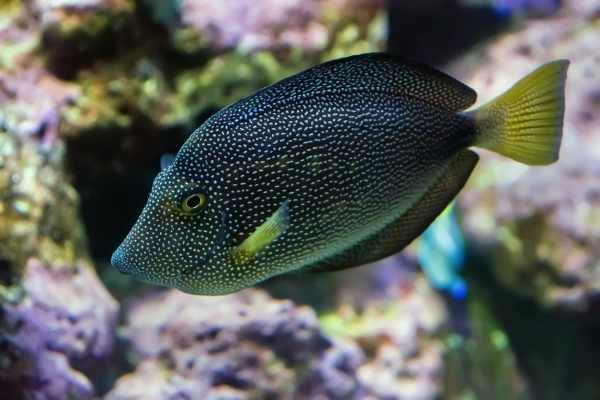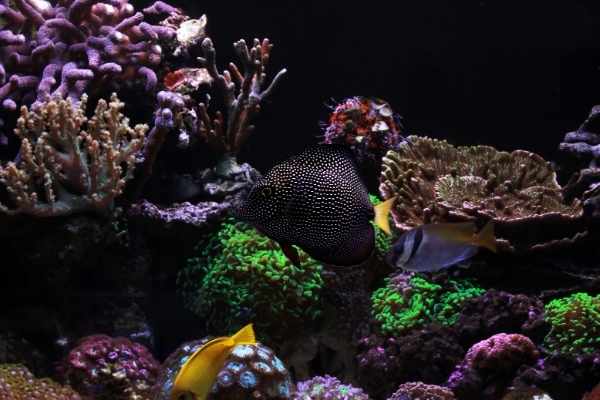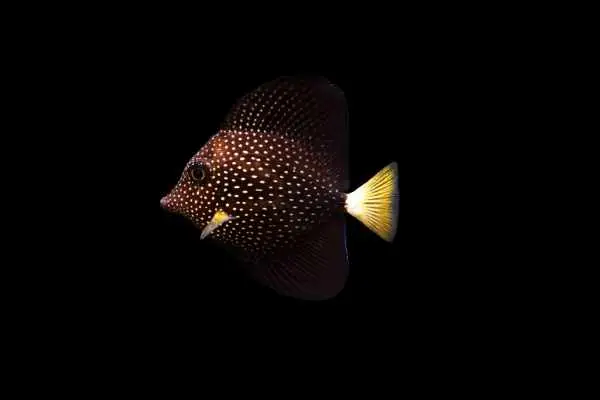The Gem Tang (Zebrasoma gemmatum) holds the honor in the tang world as fetching the highest prices. Even juveniles command four digits. They may not be the flashiest members of the tang family, but they’re still stunning to behold. And if you’re going to spend THAT much on one of these gems (no pun intended), you’ll want to make sure you’re at the top of your game.
Table of Contents: Gem Tang Care
Odds are, you have a particular topic in mind. The following links will guide you through every aspect of gem tang care. For the best information, though, you’ll want to read the entire article and make sure you’re protecting your investment.

Quick Facts
- Common Names: Gemmatum tang, Mauritius tang, Spotted tang
- Scientific Name: Zebrasoma gemmatum
- Size: Up to 8.7 inches (22cm)
- Minimum Tank Size: 180 Gallons (681L)
- Reef Safe? Yes
- Care or Experience Level: Moderate
- Preferred Diet: Herbivore
- Original Part of the World: Western Indian Ocean
Description of the Gem Tang
True to the typical tang model, gem tangs are saltwater fish that have flattened, disc-shaped bodies. Their background of dark blue scales features a stunning array of tiny white spots. Add in bright yellow touches to the fins and tail, and you have a glamorous fish.
Juveniles don’t have the vibrant colors you see in adults. Those deeper hues come in as they get older and mature. So if you have your heart set on owning one of these expensive saltwater beauties, have patience. That youngster may not look as impressive yet, but it will down the road.
As members of the surgeonfish family, gems keep their “scalpels” on either side of the caudal peduncle. And while gem tangs may not tip the scale on aggression, they exhibit the same territoriality and intolerance for others of their species as other tangs. You need to remember the presence of those scalpels when you attempt to handle these fish, so you prevent injury.
The infamous gem tang price tag comes from their location in the wild. They range throughout the western Indian Ocean, but they congregate around Mauritius, in particular. And these spotted fish LOVE the surge zones. This makes them challenging for people to collect. And Mauritius doesn’t have a large airport. Individuals need to dive for the fish, carefully place them in bags and transport them to the nearest airport. The fish then go to a holding facility where they get unbagged, REBAGGED, and then put on another plane. That’s A LOT of transportation and handling the fish wholesaler needs to account for. And who are they going to pass the cost onto? That’s right – you. And since gems don’t swim in shoals, collectors don’t find more than one outing, typically. Low supply and high demand? That drives the cost through the roof.
Gem Tang Lifespan
Most gem tang enthusiasts handle their saltwater treasures with a delicate touch. And for a good reason. These hardy members of the surgeonfish group hang out in deeper waters. Subsisting on an herbivore diet, they live up to TEN YEARS. Of course, that depends on pristine care. (Not to mention surviving all of the flights they need to take to arrive in your marine aquarium)

Creating the Ideal Gem World
Divers spot gem tangs everywhere from Mozambique to the Reunion Islands. These spotted gems (it’s too hard to pass up the puns, it really is) dart in and out of the rocks with their pointed snouts. While nowhere near the size of the sailfin tang, they hold their own. But when startled, they duck into the closest rocks to hide. And that’s the environment you want to replicate.
Live rock is the perfect décor for gem tangs. The natural surfaces provide crevices to explore – and a ready food source – while caves give them somewhere to hide. And your gem will probably feel shy when first introduced to the tank. This is normal. Once they settle in, they’ll come out into the open and set up a territory.
You DON’T want to crowd your reef tank, though. These fish are active swimmers. They need plenty of room to spread their fins and explore. It’s a careful balance between the two. Your goal is to keep your gem tang’s stress levels as low as possible. This will ensure it remains healthy. Otherwise, you may find yourself battling health problems.
While hardy by nature, gem tangs require a high level of water quality. You’ll want to perform frequent water tests to make sure your tank’s remaining well-cycled. Remember, you spent a small fortune on that fish. The last thing you want is for your gem to die of marine ich. (And, yeah, they probably brought the infestation with them through all of those plane flights)
And while they prefer deeper waters in the wild, they appreciate quality lighting in captivity. This will also help YOU, as it’ll allow those pops of yellow to stand out in the marine tank. Not to mention proper lighting will keep the live rock thriving nicely, keeping your gem well-fed.
Gem Tang Tank Size
Gem tangs aren’t the largest group members, but they need room to graze and explore. As such, you want to invest in a tank of at least 180 gallons (681L). It sounds HUGE, and it is. (Not to mention expensive – AFTER you shelled out around $3,000 for the fish) But you’re providing swimming room, LOTS of live rock, and hiding places. You don’t want to attempt to squish a gem into a small or narrow tank. And the more extensive a marine tank, the easier you’ll find balancing the water quality. So grit your teeth and spring for the biggest size possible.
Are Gem Tangs Reef-Safe?
Gem tangs are herbivores and are reef-safe. They can share a tank with corals and other invertebrates safely and without aggression.
Gem Tang Diet
Gem tangs order from the herbivore side of the menu. The easiest way to accomplish this? Install plenty of live rock within your reef tank. The best macroalgae cultures for gems include Caulerpa prolifera and Caulerpa mexicana. As long as your live rock’s healthy, you’ll see your gem grazing throughout the day.
However, if you have other herbivores in the tank, you’ll need to supplement those greens. This is easy enough to accomplish. You can add a veggie clip to the aquarium three times a day to ensure your gem tang gets the vital nutrients it needs. Acceptable vegetarian options include:
- Broccoli
- Nori
- Zucchini
Of course, you also have spirulina-based commercial foods. Ocean Nutrition’s Seaweed Selects works well, as does Seaweed Salad. The frequency is critical, as these fish feed throughout the day. If you see health issues or aggression cropping up, it means they aren’t getting enough calories.
And while it sounds counterintuitive, you should also add some items from the other side of the menu. Even herbivores need meat-based proteins now and then. Brine and mysis shrimp work well, and they’ll help your gem’s colors continue to stand out.

Gem Tang Behavior and Tank Mates
Realistically, you’re probably not going to buy more than one gem tang. And that’s for the best. Like the majority of the tang clan, gems DON’T like one another. Actually, they don’t like anyone in the Zebrasoma genus. (No clue how they know, but they do) And if a fish shares the same flattened, disc-like appearance, your gem tang will target it for bullying. But, otherwise, they’re pretty peaceful.
If you feel brave – and have a small fortune to spare – you CAN attempt to house two gems together. You’ll need a MASSIVE tank, though. And they need to enter the marine aquarium at the same time (no trying to save money over time). You should also have a SECOND tank on stand-by because there’s a chance the experiment won’t work. (This is why most people happily settle for one of these costly beauties)
Luckily, gem tangs DO get along with plenty of other saltwater aquarium fish. You need to make sure their tank mates aren’t prone to fin-nipping. And you should eliminate anyone with their own aggression issues. But the following groups share space without a problem:
- Assessors
- Blennies
- Dartfish
- Gobies
Fish with a similar shape won’t work. Gem tangs start to question whether you’ve brought another tang into the mix (even when you haven’t). You can TRY it, but you may end up with territorial aggression. You’re taking a considerable risk with these groups:
- Batfish
- Rabbitfish
- Triggerfish
And while they look NOTHING alike, you don’t want to mix pipefish or seahorses with gems. The poor things are simply too slow. They share some of the same diet, and they may end up starving. It’s not fair to add them to the community.

Breeding the Gem Tang
Male and female gem tangs look almost identical. Attempting to determine which you have will likely end up impossible. And since you probably won’t be able to manage more than one gem due to their aggression with each other, odds are you WON’T find yourself setting up a breeding operation any time soon.
But don’t feel bad – no one’s successfully bred gem tangs in captivity. (Another thing contributing to that ridiculous price tag) In the wild, males and females swim toward the surface and release eggs and sperm. The resulting larvae are planktonic. They drift with the currents, and no one’s quite sure of the length of time for their development. Trying to replicate that in a marine tank? Yeah, not a simple task.
Pros and Cons
No one’s going to argue that gem tangs aren’t beautiful. But when you start scanning price tags, you may have heart failure. It’s enough to make you consider their pros and cons VERY carefully:
Pros
- Gem tangs are herbivores. Content to feed on macro and microalgae, they’re entirely reef-safe.
- Provided you maintain a high water quality, gems are hardy saltwater fish.
- Gem tangs are active swimmers, exploring and grazing along live rock throughout the day. This makes them engaging fish for aquarists to keep.
Cons
- The average cost of a gem tang runs between $1,000-$6,000 due to the complications of their collection.
- When stressed, gems are prone to marine ich and Uronema – a nasty protozoan infection. They require careful treatment to prevent secondary infections.
- No captive breeding programs have yet been established for gem tangs, causing aquarists to rely on wild-caught specimens.
For More Information
Even with astronomical price tags, people can’t stay away from gem tangs. Whether it’s the surgeonfish shape or their unique colors, something draws people in. And there’s even more information below to keep you in awe.
This YouTube video shows a gem tang happily sharing a reef tank with a black tang (hey, it’s not a Zebrasoma species!).
Want to learn more about the best gem tang tank mates?
Why not learn about the fish that CAN’T share tank space with gems?
Or you can check out other members of the tang family – more AFFORDABLE members:
Conclusions
Gem tangs are an investment – literally. Between saving your pennies to purchase the fish in the first place (a juvenile may save you a little) and buying that enormous tank, you’re going to need a savings account. The beautiful play of white stars on a black sky, though? You can’t beat that.
But you need to protect your investment. Keep the water quality as pristine as possible. And make sure you have plenty of live rock and quality vegetables for your gems to feed on. With minimal stress, your gem will remain sparkling for years to come.
References
- Fatherree, J.W. 2009. Aquarium Fishes: Surgeonfishes, AKA The Tangs.
- Fenner, Robert. 2013. Surgeons, Tangs, and Doctorfishes. Family Acanthuridae.
- Fenner, Robert. 2015. The Sailfin Tangs, Surgeons, Doctorfishes of the Genus Zebrasoma.
- Randall, John E. 2001. Surgeonfishes of Hawaii and the World.


Leave a Reply